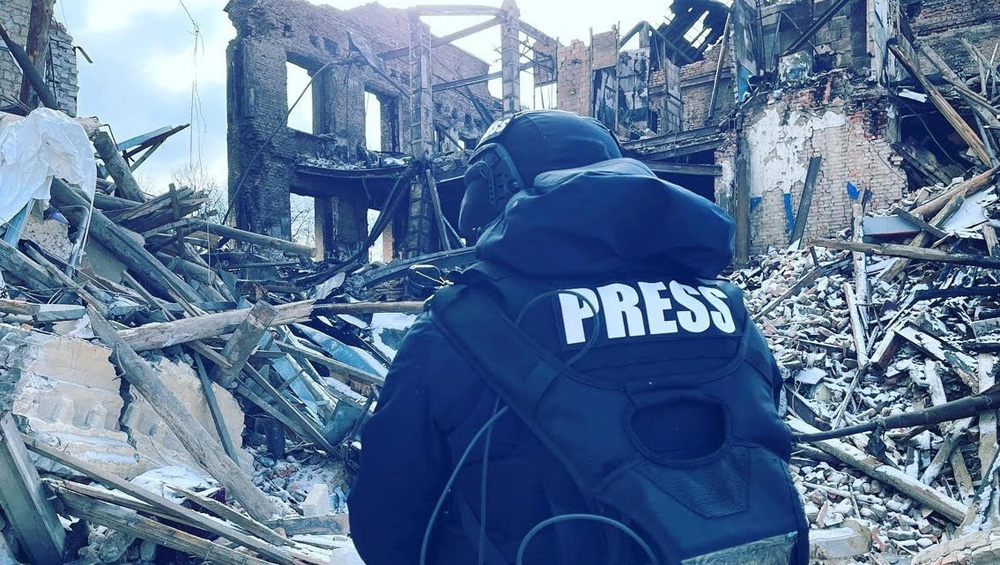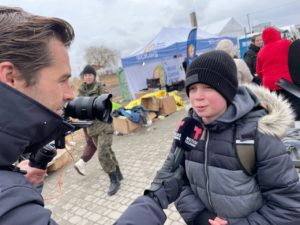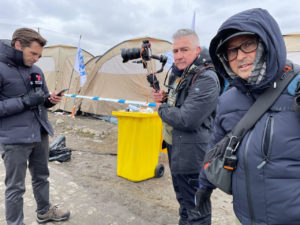
Fox News, Telemundo Lean On IP Technology For Ukraine War Coverage

As Russia’s invasion of Ukraine extends into its second month, broadcast and cable networks covering the conflict are relying heavily on compact IP contribution systems, including LiveU and TVU bonded cellular systems, and a variety of lightweight cameras to produce both live shots and edited packages from Ukraine and its border countries.

Telemundo anchor Julio Vaqueiro interviewing a young Ukranian refugee in Poland.
With the lack of a true front line and frequent long-range missile and rocket attacks, the conflict in Ukraine has been particularly challenging and dangerous for journalists. Five journalists have been killed covering the war so far, according to the advocacy group Reporters Without Borders. They include two working for Fox News Channel who were hit by artillery fire in Kyiv on March 14: Pierre Zakrzewski, a 55-year-old cameraman; and Olexandra Kuvshynova, a 24-year-old Ukrainian journalist who was working as a local consultant or “fixer.”
FNC correspondent Benjamin Hall was seriously wounded in the same attack but was successfully evacuated from the war zone to a U.S. military hospital in Germany. Last week, Hall was then transferred to Brooke Army Medical Center (BAMC) outside of San Antonio, Tex., where he continues to recover.
“Our challenge, certainly even prior to the tragedy that took place, is there is no true front line in the conflict and there’s no side for them to be embedded,” says Scott Wilder, FNC’s VP of field & production operations. “We’ve spent 20-plus years covering other conflicts, most notably Iraq and Afghanistan, and I certainly wouldn’t say they were easy. But you had the luxury and ability to embed with forces, which really were your supply chain and safety net in many ways. We just don’t have that here.”
Supply Chain Severed
In past wars FNC covered, the conflict was also already underway. This time, FNC sent personnel and equipment into Ukraine back in February before the invasion, when they were able to fly directly into Kyiv and set up shop. Now that supply line has been cut, Wilder says, and “whatever equipment you have or had in there is what you’re living with.”

Fox News Channel correspondent Trey Yingst reporting from the field.
FNC planned for that eventuality by packing lightweight, portable IP contribution systems to get feeds out instead of relying on heavy gear like traditional satellite trucks. FNC does have a traditional SNG truck at its London bureau and back in February briefly “flirted with the idea” of making the very long drive to Kyiv, Wilder says, but decided against it. Instead, the network outfitted its three-person crews (correspondent, producer and camera operator) with LiveU LU300 bonded cellular backpack units, supplemented by Cobham Explorer 710 BGAN Ka-band satellite terminals.
“It’s about paring down and taking in very little,” Wilder says.
There are three FNC teams currently in Ukraine, along with another five based in Poland (including crews from Fox Business) and moving around between there and other border countries including Romania, Moldova and Hungary. There is also a coordinating producer and an engineer in Ukraine to deal with any technology issues.
Bracing For Connectivity Issues
For routine international coverage such as a presidential trip, FNC often combines the bandwidth of its LiveU units with other IP sources, such as the Wi-Fi in a hotel or convention space. That allows it to achieve rock-solid connections of up to 10 Mbps. It sent the BGANs to Ukraine so its crews there could get by with far less.
The BGAN terminals include an integrated antenna and transceiver and are roughly the size of a large laptop, weighing 7 pounds. They stream at a minimum of 600 kilobits per second and can be fed as an additional IP data channel into the LiveU units, which use HEVC encoding and can function with very low bandwidth in areas with poor cell coverage.
“That was our plan going in, that we were going to have to use the BGAN units when the hotel internet went down and cellphones went down,” Wilder says. “We’re kind of happy and lucky to report that that still has not happened [as of March 25].”
The connectivity in Ukraine has been so good that FNC has edited only a few packages on the ground. Instead, the network has been able to use LiveU bonded cellular systems to send back raw video to New York for editing there on Adobe Premiere systems. FNC’s Dalet system in New York handles ingest and asset management and supports remote access for the many FNC editors who are still working from home due to the pandemic.
“The workflow really has changed with the advent of LiveU and bonded cellular technology with the ease of getting material back to New York at headquarters, or wherever they may be,” Wilder says. “They’ve made it so easy, the material is all here.”

A NewsSpotter Ka-band dish at Fox’s hotel in Lviv. (Courtesy Fox News Channel)
As another transmission option, FNC also sent two Cobham Explorer “NewsSpotter” .75 meter Ka-band antennas, which run on the Viasat network and offer scalable service at bitrates ranging from 512 kbps up to 10 Mbps. The network sent one NewsSpotter it already owned from its London bureau and rented a second. It has been using them occasionally in Lviv to do some live anchoring from there.
“The reality is maybe we would be good without it, because the hotel internet is good,” Wilder says. “But we’re still in a posture where we’re waiting for any moment for the hotel internet to go down or get throttled.”
Wilder notes that both BGAN and NewsSpotter are costly services, so what FNC might use for a reporter’s live shot might be different than it what it does for anchor coverage. The same goes for primetime versus daytime.
Telemundo Tackles Border Coverage
Another American network relying heavily on bonded cellular technology for its coverage of the conflict is Spanish-language broadcaster Telemundo. The NBCUniversal-owned network traveled to Poland earlier this month to report on the humanitarian crisis there as millions of Ukrainian refugees streamed across the border.

Telemundo’s gear ready to roll.
Telemundo presented its 6:30 p.m. nightly newscasts from Poland for a week with anchor Julio Vaqueiro reporting, supported by photographer Mauricio Gutierrez and Jeff Liebman, Telemundo’s director of network news operations. Telemundo also delivered live inserts during its morning show hoy Día and contributed edited packages for other Telemundo newscasts and digital outlets, using Avid Newscutter software on Apple laptops.
For its live broadcasts, Telemundo relied on LiveU bonded units for contribution, sometimes in combination with BGAN terminals (the BGAN terminals were always on standby as a backup). And to move recorded and/or edited content on a store-and-forward basis, it used LiveU’s store-and-forward mechanism as well as software from file-transfer specialist Latakoo. Liebman said he was pleasantly surprised at how well the bonded systems performed.
“I think there were only or two times when I had to pull out the BGAN to get us over the threshold,” Liebman says. “4G service was widely and readily available throughout Poland. It could have been much worse, and we were prepared for it to be much worse, but we found the cellular environments down there to be stable and strong.”
While many other news networks were relying on the same cellular signals, Liebman says the few times that Telemundo experienced significant connection issues was when thousands of refugees were simultaneously streaming across the border carrying smartphones. He notes that was an interesting twist, as one tends to think of refugees as being underprivileged. But many of the Ukrainian refugees were middle-class people, he says, and “they were all carrying iPhones and various other devices that were competing with us for bandwidth.”
Liebman always tries to pack as light as possible for field coverage, but when traveling to a foreign country it is essential to bring backups because of the difficulty in replacing broken kit like a failed cable. Telemundo’s audio, video and transmission essentials fit into about six cases, which made the trip by plane from Miami to Amsterdam, then to Krakow, Poland, followed by a three-and-a-half-hour car trip to Reznow, where the crew stayed in a hotel.
Reaching the Ukrainian border required another one-and-a-half-hour trip each day, followed by a lot of walking after navigating checkpoints and parking. Having a relatively light assortment of gear was helpful, Liebman says, and also made the news crew less conspicuous. Since the trip back to the hotel was lengthy, the crew fed packages through Latakoo in some innovative ways, which including paying a local cafe owner to plug into her router.
Array Of Gear
While a traditional shoulder-mounted ENG camcorder still plays a strong role in daily news coverage, Liebman says the modern photographer needs an array of gear to meet audience expectations. In Poland, Telemundo used a combination of the Sony PXW-FX9 shoulder-mounted camcorders and a handheld Sony A7S-Mark III mirrorless digital camera on a DJI Ronin, a 3-axis stabilization system. The mirrorless Sony camera was paired with a prosumer-level Rode wireless microphone system to keep the weight down.
“That camera worked well for our morning live shots,” Liebman says. “For our morning program, we were trying to give it a lot of movement. That was a great time to be doing live shots, walking around these camps and border checkpoints that had a lot of activity.”

Telemundo anchor Julio Vaqueiro, photographer Mauricio Gutierrez and director of network news operations Jeff Liebman on the ground in Poland.
Telemundo also used a combination of GoPros and iPhones. In one instance, it teamed with a Polish citizen who was volunteering as a free taxi service to incoming refugees by placing GoPros inside his car and also doing a Zoom call with him from the road.
FNC’s photographers also used a mix of cameras. They included the Sony PXW-X400, a traditional shoulder-mounted camera with a mounted Canon lens and a companion camera that could be either a Sony PXW-Z280 handheld camera or a Sony PXW-Z90, which Wilder describes as “a borderline prosumer camera” with XLR audio and SDI outputs.
FNC tries not to dictate what cameras photographers should use and lets them pick the right tool for the job. The PXW-X400 has been used a lot at night in Lviv, where police have asked news crews to keep their light dim and low-light sensitivity is important. Safety is always the key priority in setting up live shots.
“You’re in Lviv and going to the train station, maybe you’re bringing a tripod or a monopod,” Wilder says. “Anything outside of those safe parameters, it’s handheld and maybe a monopod at best.”
He says improvements in technology have certainly made it easier deploy for FNC to deploy its personnel with all of the equipment they need.
“When we covered the last conflict in Ukraine, the annexation of Crimea [in 2014], we sent a real-size traditional flyaway dish that took two engineers, multiple cases, generators and fuel,” Wilder recalls. “To get that technology into one case now [with the NewsSpotter unit] has kind of been a gamechanger — even though, most notably, we haven’t really needed it.”
































Comments (0)